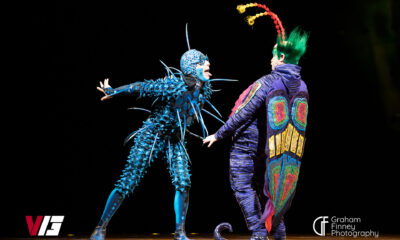Reviews
Ran (#058)
100 Films for 100 Rainy Days

Directed by: Akira Kurosawa » Written by: Akira Kurosawa, Hideo Oguni & Masato Ide » Based on the Play “King Lear” by: William Shakespeare, 1986 » Region/Time: Japan, colour, 160 minutes.
Starring: Tatsuya Nakadai as Lord Hidetora Ichimonji » Akira Terao as Taro » Jinpachi Nezu as Jiro » Daisuke Ryu as Saburo » Mieko Harada as Lady Kaede » Peter as Kyoami » Yoshiko Miyazaki as Lady Sué.
“Are there no gods… no Buddha? If you exist, hear me. You are mischievous and cruel! Are you so bored up there you must crush us like ants? Is it such fun to see men weep?” – Kyoami
“It is the gods who weep. They see us killing each other over and over since time began. They can’t save us from ourselves.” – Tango

While Ran is nominally a retread of King Lear, it has a different point-of-view than Shakespeare’s work. Whereas in King Lear the vagaries of fate/God took front stage (“As flies to wanton boys, so we are to the gods. They kill us for their sport.”), Ran posits a world of an indifferent God, who watches without interfering, as we make life hell for one another. Kurosawa doesn’t make it clear if the Gods watch with amusement or sorrow. In the 17 years between 1948 and 1965, Kurosawa directed 17 films, many of which are recognized classics – all of which are worthwhile (see No. 65, Ikiru). In the years between 1965 and his death in 1998, Kurosawa made only seven films. In these later years, after the financial failure of Red Beard (1965), his films fell out of favour in Japan and were deemed “old-fashioned.” Kurosawa had been trying to raise the finances required for Ran since 1975, but was unable to do so. He regarded his excellent 1980 film Kagemusha (available on blu-Ray from Criterion!) as a “dress rehersal” for what would be his most ambitious film ever and, at $12 million (US), the most expensive Japanese movie ever filmed to that date.
Ran begins with Lord Hidetora of the Ichimonji clan presiding over a meeting with neighbouring clans, who are offering their daughters’ hands in marriage to his three sons; Taro, Jiro and Saburo. As the film progresses, it becomes clear that Hidetora has been a tyrant, who pillaged and razed castles, killing noblemen and waging war. He is now an old man, however, and falls asleep during the meeting. He has a horrible nightmare and, as a result, decides to split his kingdom. He hands each of his sons an arrow and asks for them to snap it. After easily snapping each arrow, Hidetora shows them three arrows and tells them that together, three arrows cannot be snapped. Saburo smashes the bundle across his knee, calls the lesson stupid and tells his father that he is foolish to split the kingdom, predicting blood, war and ruin. Taro is given dominion over the lands and First Castle, Jiro is given the Second Castle and Saburo is given the Third Castle, but it banished as a result of his defiance over his father’s policies. Hidetora tells each son that he will visit them in turn as an honoured guest in their castles.

At the First Castle, Taro’s wife, Lady Kaede, tells Taro this used to be her family home before she begins to turn him against his father. When Hidetora’s personal guard causes troubles in the castle, Taro tells him that he has no need of an escort since he has renounced his power. Hidetora responds that “Only the birds and the beasts live in solitude.” In anger, Hidetora signs a declaration ceding his power to Taro and leaves for the Second Castle. He is also unwanted by Jiro and retreats to the vacant Third Castle. Midway through the movie, both Jiro’s and Taro’s armies slaughter his personal guard, burning down the Third Castle. Betrayed by his sons, unable to commit hara-kiri, without an army and without a castle, Hidetora goes mad and is left to wander the plains with his jester, Kyoami and his advisor, Tango. Kyoami relates a parable to Lord Ichimonji about a bird who leaves his speckled egg for a pure white one, only for a snake to hatch and eat the bird. “Stupid bird!” When Hidetora bemoans “I am lost,” his jester responds “Such is the human condition.”

Meanwhile, Taro has been killed by Jiro, who has taken his place as head of the Ichimonji clan. Lady Kaede makes sure that she becomes Jiro’s wife and orders that he kill his current wife, Lade Sué. Jiro’s advisor warns him against being ruled by Lady Kaede, whom he recognizes as evil and conniving (“A warrior does not run to his wife”). Hidetora is eventually reunited with his third son, Saburo, who loves him. As Saburo and Jiro’s armies stand against each other, Lady Kaede convinces Jiro to go to war against his remaining brother and to assassinate him. While the armies are locked in combat, a neighbouring warlord takes over the First Castle. Jiro arrives at the last minute and is told to prepare for death. While the First Castle burns, Lady Kaede admits that it has all gone according to her plan to destroy the Ichimonji clan. She is beheaded and the film ends with a blazing red sun and a blind ex-emperor teetering on the edge of an abyss.
Hidetora is played by Tatsuya Nakadai. Over a relatively short period in the 1960s, Nakadai became one of the great Japanese actors, starring in Kurosawa’s High and Low (1963) and Red Beard (1965), as well as Mikio Naruse’s When a Woman Ascends the Stairs (1960) and Masaki Kobayashi’s Harakiri (1962), all of which are well worth watching. As the Emperor in Ran, Nakadai was buried under layers of kabuki make-up and a flowing white beard. Compared to the more realistic styles of acting of the majority of the characters, Nakadai was made to play Lord Hidetora with stylized, Noh-like gestures.

Colour plays an important role in the film. Indeed, in many shots, we can recognize the different armies by their colours. Taro is represented by yellow, Jiro by red and Saburo by Blue. The other clans are represented by white and black, but do not take part in on-screen battles. Most impressive of all, the film uses over a thousand extras—all of which required uniforms and suits of armour to be fabricated—and hundreds of horses. These were designed by costume designer Emi Wada and Kurosawa, and were hand-made by master tailors over more than two years. Ran was shot in the mountains and plains of an active volcano, Mount Aso, allowing for many shots in which the action takes place in the far distance, behind the main characters. However, unlike his earlier films, such as Seven Samurai or Yojimbo, the battles scenes do not put the viewer in the centre of the action and do not create a visceral experience. Instead, the battles are often shown from a vast distance, keeping us at a God’s distance from the action and forcing us to merely observe as the Ichimonji clan is brought to its knees. For Ran Kurosawa assembled many of his previous collaborators, including scriptwriters, the costume designer, art directors and the cinematographers. Indeed, by the time he began filming, Kurosawa’s eyesight had almost completely deteriorated and he would frame shots with the help of assistants, using his paintings as guidelines.
In fact, Roger Ebert believes that while Ran, which roughly translates to “chaos” in Japanese, seems to be about war, it is actually in large part about Kurosawa himself, at 75 years old, and the hubris that comes from old age. In Ran, Hidetora believes he has solved the problems of his sons and the future generation, only to have the avarice of his sons as well as his own mistakes and past behaviours work against him. Another critic, Michael Wilmington, believes that Ran is really about the threat of nuclear apocalypse, a looming threat at the time the film was created. “We’re watching, in the hands of a master (a sensei), a great metaphor of the apocalypse, a world in flames whose chaos is made strangely beautiful.” There are many parallels to both interpretations of the work.

Ran was eventually nominated for several Academy Awards including Best Director, a rare feat for a foreign film. It won for only Costume Design, but nonetheless takes its place as one of the greatest spectacles ever put on film.
Up Next in the Film Canon: An early sound film full of boat rides, cats and honeymoons.
-

 Music4 days ago
Music4 days agoTake That (w/ Olly Murs) Kick Off Four-Night Leeds Stint with Hit-Laden Spectacular [Photos]
-

 Alternative/Rock5 days ago
Alternative/Rock5 days agoThe V13 Fix #010 w/ High on Fire, NOFX, My Dying Bride and more
-

 Hardcore/Punk2 weeks ago
Hardcore/Punk2 weeks agoHastings Beat Punks Kid Kapichi Vent Their Frustrations at Leeds Beckett University [Photos]
-

 Culture2 weeks ago
Culture2 weeks agoCirque Du Soleil OVO Takes Leeds Fans on a Unique, Unforgettable Journey [Photos]
-

 Alternative/Rock2 weeks ago
Alternative/Rock2 weeks agoA Rejuvenated Dream State are ‘Still Dreaming’ as They Bounce Into Manchester YES [Photos]
-

 Features4 days ago
Features4 days agoTour Diary: Gen & The Degenerates Party Their Way Across America
-

 Culture7 days ago
Culture7 days agoDan Carter & George Miller Chat Foodinati Live, Heavy Metal Charities and Pre-Gig Meals
-

 Music6 days ago
Music6 days agoReclusive Producer Stumbleine Premieres Beat-Driven New Single “Cinderhaze”




